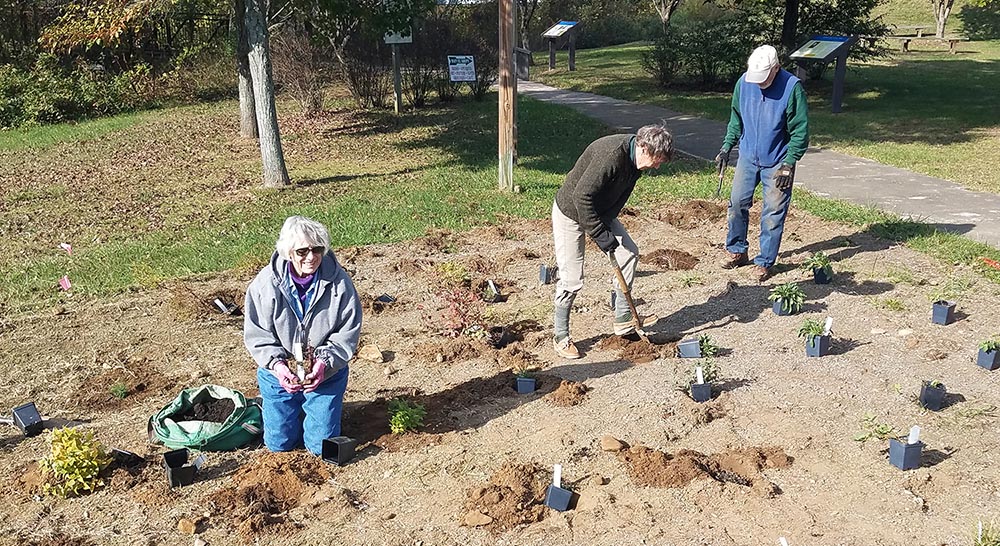 Volunteers help plant native species in the new pollinator garden by the Thorton River in Sperryville, Va. Photo by Celia Vuocolo.
Volunteers help plant native species in the new pollinator garden by the Thorton River in Sperryville, Va. Photo by Celia Vuocolo.
“PEC partnered with the Endangered Species Coalition (ESC), Cliff Miller Jr. and RappFLOW to install a pollinator garden next to a walking trail by the Thornton River in Sperryville, Va. Using native plants such as perennials, grasses and shrubs from Hill House Farm and Nursery, the garden was installed during a volunteer planting event this past fall.
Celia Vuocolo, PEC’s wildlife habitat and stewardship specialist, is working with the ESC on their rusty patched bumble bee education campaign (the rusty patched was listed as federally endangered this past year — the first bumble bee to have that designation in the United States). The pollinator garden is part of the campaign to raise awareness for the plight of the rusty patched and other pollinators, including the monarch butterfly. Thirteen plant species were chosen for the new garden, and will provide nectar and pollen sources from April to October.
A sister garden was planted two weeks earlier in Fauquier County, between the Town of Warrenton’s Greenway trail and a new dog park. Native plants for that garden were supplied by Piedmont Nursery in Markham. Interpretive signs will be installed at both sites.
“It’s imperative that we do more to protect the at-risk pollinator species — including those currently listed as threatened or endangered — by expanding their habitat with new pollinator-specific gardens in Virginia and elsewhere throughout the country,” says Leda Huta, executive director of the ESC. “We are happy to partner with the Piedmont Environmental Council to help establish these special pollinator gardens in Warrenton and Sperryville, which will provide much needed habitat for the rusty patched bumblebee, monarch butter y and other imperiled species.”
The last sighting of the rusty patched (Bombus affinis) in the Mid-Atlantic was also the last known one in Virginia. In 2014, citizen scientists from the Smithsonian Conservation Biology Institute’s Virginia Working Landscapes program found one at Sky Meadows State Park. Prior to this finding, it had been several years since the bumble bee had been observed and was thought to have been extirpated from the Mid-Atlantic region. The rusty patched bumble bee’s population has declined by over 80 percent over the past 20 years.
“The monarch and the European honey bee have been the poster children for pollinator decline, but we have hundreds of native bee species in the United States that are at just as much risk. The best thing a homeowner can do to help pollinators is plant Virginia native plants that are pesticide-free, and that’s exactly what we are doing with this project,” says Celia.
If you are interested in planting natives to help the rusty patched bumble bee and other at-risk pollinators, visit www.pecva.org/gonative to view PEC’s Go Native Go Local guide for a listing of nurseries that carry native plants.
“Bumble bees are generalists, meaning that they visit a lot of different flowers, as opposed to other pollinators that specialize on certain plants,” says Celia. “The important thing to remember when selecting plants for native bees is variety. Variety of color, flower shape and size, and bloom time. You need to make sure you have native flowers blooming all through the growing season. And don’t forget your trees and shrubs! In the early spring, woody plants are the main source of nectar and pollen for bees.”
This article was written featured in our Spring 2018 member newsletter, The Piedmont View.
